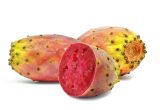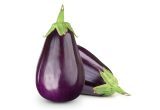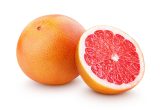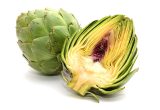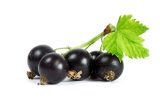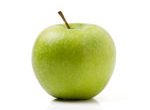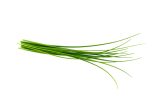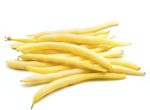Tomato (cherry)

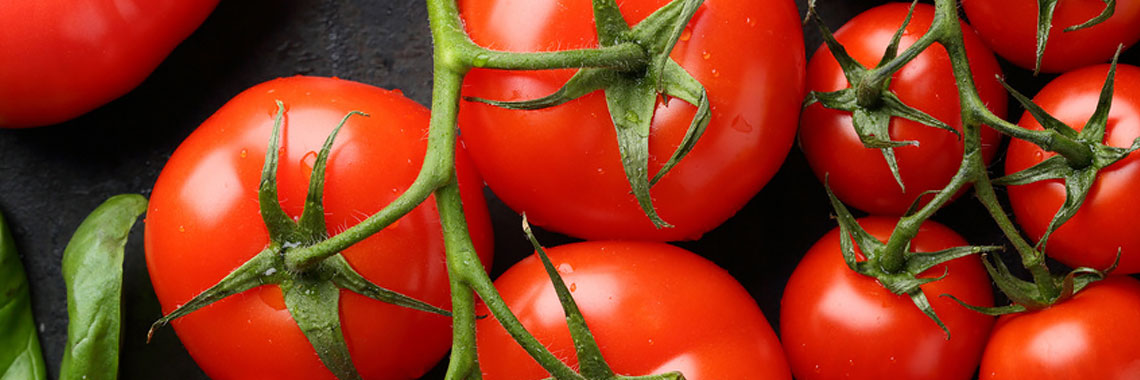
Description
- The cherry tomato belongs to the Solanaceae family, genus Solanum, species Solanum lycopersicum esculentum M.
- This fruit was created in Israel in the 1980s (Wexler, 2016). Initially known as an ornamental plant, its cultivation spread to France in the 19th century (Klorane Botanical Foundation, 2017).
PHYSICAL AND ORGANOLEPTIC CHARACTERISTICS
- Round or olive-shaped, the cherry tomato does not exceed a diameter of 3 to 4 cm.
- During its development, the pigments responsible for its colour are predominantly chlorophylls a and b. When ripe, chlorophyll levels decrease sharply while the relative proportion of violaxanthin, lutein, β-carotene, lycopene, antheraxanthin and zeaxanthin is up to 9 times higher (Carrari, 2006).
- Its content of glucose, fructose and sucrose, but also organic acids such as citric acid and malic acid, gives it a sweet yet slightly acidic taste that makes it highly appreciated (Zhao, 2016).
COMPOSITION CHARACTERISTICS (excluding macronutrients, vitamins and minerals)
- The cherry tomato has notable quantities of flavonols, including rutin, kaempferol rutinoside and naringenin chalcone (NC), which gives it antioxidant and modulating properties at the cellular level. Furthermore, rutin has anti-carcinogenic, anti-microbial, anti-inflammatory properties and protects against heart disease. Kaempferol rutinoside can be used for wound healing and NC, the main active component of tomato skin, has anti-allergic activity (Wang, 2018).
- Many researchers have also been interested in the beneficial effects of tomatoes in cancer prevention thanks to their bioactive compounds, including carotenoids. A cohort study with a 6-year follow-up showed that the consumption of cherry tomatoes was associated with a lower risk of prostate cancer thanks to a high presence of lycopene between 7.8 and 18.1 mg per 100 g (Willett, 1995). A meta-analysis confirmed that higher consumption of β-carotene, α-carotene, lycopene, β-cryptoxanthin, lutein and zeaxanthin reduced the risk of oesophageal cancer (Ge, 2013).
RAW
The following values are approximate and depend on variety, season, ripeness, cultivation conditions, etc. Raw cherry tomato is low in energy*. On average, it provides 33.70 calories (kcal) per 100 g, i.e. 142 kJ.
COMPOSITION TABLES
For each nutrient, the tables provide information on the content, minimum and maximum values, as well as the percentage of the Dietary Reference Values (DRVs) for 100 g net of raw cherry tomatoes (except for the table on polyphenols, which refers to raw tomato – unknown variety).
* Regulation (EC) No 1924/2006 of the European Parliament and of the Council of 20 December 2006 on nutrition and health claims made on foods.
MACRONUTRIENTS
| Constituent (g) | Average content |
Min-Max per 100g |
DRV% |
|---|---|---|---|
| Water | 90,1 | - | - |
| Fibers | 1,20 | - | - |
| Carbohydrates | 5,62 | - | 2,16 |
| Sugars | 4,70 | - | 5,22 |
| Lipids | < 0,50 | - | - |
| Saturated fat | < 0,01 | - | - |
| Protein | 1,31 | - | 2,62 |
| Constituent (g) | Amount | Min-Max | DRV% |
|---|---|---|---|
| Water | Ciqual 2020 (valeur issue des analyses Ciqual-Aprifel 2017) | - | - |
| Fibers | Ciqual 2020 (valeur issue des analyses Ciqual-Aprifel 2017) | - | - |
| Carbohydrates | Ciqual 2020 | - | Règlement (UE) N°1169/2011 du parlement Européen, et du conseil du 25 octobre 2011 |
| Sugars | Ciqual 2020 (valeur issue des analyses Ciqual-Aprifel 2017) | - | Règlement (UE) N°1169/2011 du parlement Européen, et du conseil du 25 octobre 2011 |
| Lipids | Ciqual 2020 (valeur issue des analyses Ciqual-Aprifel 2017) | - | Règlement (UE) N°1169/2011 du parlement Européen, et du conseil du 25 octobre 2011 |
| Saturated fat | Ciqual 2020 (valeur issue des analyses Ciqual-Aprifel 2017) | - | Règlement (UE) N°1169/2011 du parlement Européen, et du conseil du 25 octobre 2011 |
| Protein | Ciqual 2020 | - | Règlement (UE) N°1169/2011 du parlement Européen, et du conseil du 25 octobre 2011 |
Zoom on carbohydrates
- Raw cherry tomatoes contain a higher amount of carbohydrates (5.62 g per 100 g) than the average quantity found in raw vegetables: about 4.45 g per 100 g.
- These are mainly fructose (2.50 g per 100 g) and glucose (2.30 g per 100 g).
- The cherry tomato contains less than 5 g of sugar per 100 g, meaning it is low in sugar*.
Zoom on fibres
- Raw cherry tomatoes provide 1.20 g of fibre per 100 g.
- This amount is below the average quantity found in raw vegetables (2.43 g per 100 g).
Zoom on proteins
- Their protein content (1.31 g per 100 g) is lower than the average amount found in raw vegetables (1.87 g per 100 g).
Zoom on lipids
- With a fat content of less than 0.5 g per 100 g, cherry tomatoes are therefore fat-free*.
* Regulation (EC) No 1924/2006 of the European Parliament and of the Council of 20 December 2006 on nutrition and health claims made on foods.
MINERALS AND TRACE ELEMENTS
| Constituent | Average content |
Min-Max per 100g |
DRV% |
|---|---|---|---|
| Calcium (mg) | 6,60 | - | 0,83 |
| Chloride (mg) | 52,27 | - | 6,53 |
| Copper (mg) | 0,05 | - | 5 |
| Iron (mg) | 0,37 | - | 2,64 |
| Iodine (µg) | < 20 | - | - |
| Magnesium (mg) | 11 | - | 2,93 |
| Manganese (mg) | 0,16 | - | 8 |
| Phosphorus (mg) | 31 | - | 4,43 |
| Potassium (mg) | 330 | - | 16,50 |
| Selenium (µg) | < 20 | - | - |
| Sodium (mg) | < 5 | - | - |
| Zinc (mg) | 0,18 | - | 1,80 |
| Constituent | Amount | Min-Max | DRV% |
|---|---|---|---|
| Calcium (mg) | Ciqual 2020 (valeur issue des analyses Ciqual-Aprifel 2017) | - | Règlement (UE) N°1169/2011 du parlement Européen, et du conseil du 25 octobre 2011 |
| Chloride (mg) | Ciqual 2020 (valeur issue des analyses Ciqual-Aprifel 2017) | - | Règlement (UE) N°1169/2011 du parlement Européen, et du conseil du 25 octobre 2011 |
| Copper (mg) | Ciqual 2020 (valeur issue des analyses Ciqual-Aprifel 2017) | - | Règlement (UE) N°1169/2011 du parlement Européen, et du conseil du 25 octobre 2011 |
| Iron (mg) | Ciqual 2020 (valeur issue des analyses Ciqual-Aprifel 2017) | - | Règlement (UE) N°1169/2011 du parlement Européen, et du conseil du 25 octobre 2011 |
| Iodine (µg) | Ciqual 2020 (valeur issue des analyses Ciqual-Aprifel 2017) | - | Règlement (UE) N°1169/2011 du parlement Européen, et du conseil du 25 octobre 2011 |
| Magnesium (mg) | Ciqual 2020 (valeur issue des analyses Ciqual-Aprifel 2017) | - | Règlement (UE) N°1169/2011 du parlement Européen, et du conseil du 25 octobre 2011 |
| Manganese (mg) | Ciqual 2020 (valeur issue des analyses Ciqual-Aprifel 2017) | - | Règlement (UE) N°1169/2011 du parlement Européen, et du conseil du 25 octobre 2011 |
| Phosphorus (mg) | Ciqual 2020 (valeur issue des analyses Ciqual-Aprifel 2017) | - | Règlement (UE) N°1169/2011 du parlement Européen, et du conseil du 25 octobre 2011 |
| Potassium (mg) | Ciqual 2020 (valeur issue des analyses Ciqual-Aprifel 2017) | - | Règlement (UE) N°1169/2011 du parlement Européen, et du conseil du 25 octobre 2011 |
| Selenium (µg) | Ciqual 2020 (valeur issue des analyses Ciqual-Aprifel 2017) | - | Règlement (UE) N°1169/2011 du parlement Européen, et du conseil du 25 octobre 2011 |
| Sodium (mg) | Ciqual 2020 (valeur issue des analyses Ciqual-Aprifel 2017) | - | - |
| Zinc (mg) | Ciqual 2020 (valeur issue des analyses Ciqual-Aprifel 2017) | - | Règlement (UE) N°1169/2011 du parlement Européen, et du conseil du 25 octobre 2011 |
Zoom on minerals and trace elements
- Raw cherry tomatoes are a source of potassium* as they provide the equivalent of 16.50% of DRVs, i.e. 330 mg per 100 g.
- It also provides the equivalent of 8% of DRVs for manganese, i.e. 0.16 mg per 100 g.
- The amount of other minerals and trace elements is less than 7% of DRVs.
* Regulation (EC) No 1924/2006 of the European Parliament and of the Council of 20 December 2006 on nutrition and health claims made on foods.
VITAMINS
| Constituent | Average content |
Min-Max per 100g |
DRV% |
|---|---|---|---|
| Provitamin A Beta-carotene (µg) | 1 360 | - | - |
| Vitamin A equivalent (µg) | 226,66 | - | 28,33 |
| Vitamin B1 (mg) | 0,048 | - | 4,36 |
| Vitamin B2 (mg) | 0,018 | - | 1,29 |
| Vitamin B3 (mg) | 0,92 | - | 5,75 |
| Vitamin B5 (mg) | 0,079 | - | 1,32 |
| Vitamin B6 (mg) | 0,096 | - | 6,86 |
| Vitamin B9 (µg) | 17,60 | - | 8,80 |
| Vitamin C (mg) | 21,80 | - | 27,25 |
| Vitamin E (mg) | 0,40 | NC - 1,22 | 3,33 |
| Vitamin K1 (µg) | 2,83 | - | 3,77 |
| Constituent | Amount | Min-Max | DRV% |
|---|---|---|---|
| Provitamin A Beta-carotene (µg) | Ciqual 2020 (valeur issue des analyses Ciqual-Aprifel 2017) | - | - |
| Vitamin A equivalent (µg) | Calcul à partir de la valeur Provitamine A Béta-carotène* | - | Règlement (UE) N°1169/2011 du parlement Européen, et du conseil du 25 octobre 2011 |
| Vitamin B1 (mg) | Ciqual 2020 (valeur issue des analyses Ciqual-Aprifel 2017) | - | Règlement (UE) N°1169/2011 du parlement Européen, et du conseil du 25 octobre 2011 |
| Vitamin B2 (mg) | Ciqual 2020 (valeur issue des analyses Ciqual-Aprifel 2017) | - | Règlement (UE) N°1169/2011 du parlement Européen, et du conseil du 25 octobre 2011 |
| Vitamin B3 (mg) | Ciqual 2020 (valeur issue des analyses Ciqual-Aprifel 2017) | - | Règlement (UE) N°1169/2011 du parlement Européen, et du conseil du 25 octobre 2011 |
| Vitamin B5 (mg) | Ciqual 2020 (valeur issue des analyses Ciqual-Aprifel 2017) | - | Règlement (UE) N°1169/2011 du parlement Européen, et du conseil du 25 octobre 2011 |
| Vitamin B6 (mg) | Ciqual 2020 (valeur issue des analyses Ciqual-Aprifel 2017) | - | Règlement (UE) N°1169/2011 du parlement Européen, et du conseil du 25 octobre 2011 |
| Vitamin B9 (µg) | Ciqual 2020 (valeur issue des analyses Ciqual-Aprifel 2017) | - | Règlement (UE) N°1169/2011 du parlement Européen, et du conseil du 25 octobre 2011 |
| Vitamin C (mg) | Ciqual 2020 (valeur issue des analyses Ciqual-Aprifel 2017) | - | Règlement (UE) N°1169/2011 du parlement Européen, et du conseil du 25 octobre 2011 |
| Vitamin E (mg) | Ciqual 2020 (valeur issue des analyses Ciqual-Aprifel 2017) | - | Règlement (UE) N°1169/2011 du parlement Européen, et du conseil du 25 octobre 2011 |
| Vitamin K1 (µg) | Ciqual 2020 (valeur issue des analyses Ciqual-Aprifel 2017) | - | Règlement (UE) N°1169/2011 du parlement Européen, et du conseil du 25 octobre 2011 |
Zoom on vitamins
- Raw cherry tomatoes are a source of:
- vitamin A because they provide the equivalent of 28.33% of DRVs, i.e. 226.66 µg per 100 g;
- vitamin C because they provide the equivalent of 27.25% of DRVs, i.e. 21.80 mg per 100 g.
- They provide the equivalent of 8.80% of DRVs for vitamin B9, i.e. 17.60 µg per 100 g.
- The quantity of other vitamins represents less than 7% of DRVs.
*Calculation made: Beta Carotene / 6 + retinol
POLYPHENOLS
| Constituent (mg) | Average content |
Min-Max per 100mg |
|---|---|---|
| Flavonoids (mg) | 0,95 | - |
| of which Flavonols (mg) | 0,74 | - |
| of which Flavanones (mg) | 0,12 | - |
| of which Dihydrochalcones (mg) | 0,097 | - |
| Phenolic Acids (mg) | 2,32 | - |
| of which Hydroxycinnamic acids (mg) | 2,32 | - |
| Total polyphenols | 3,27 | - |
| Constituent (mg) | Amount | Min-Max |
|---|---|---|
| Flavonoids | Etude CTIFL-Aprifel 2017-2018 Méthode utilisée : chromatographie | - |
| of which Flavonols | Etude CTIFL-Aprifel 2017-2018 Méthode utilisée : chromatographie | - |
| of which Flavanones | Etude CTIFL-Aprifel 2017-2018 Méthode utilisée : chromatographie | - |
| of which Dihydrochalcones | Etude CTIFL-Aprifel 2017-2018 Méthode utilisée : chromatographie | - |
| Phenolic Acids | Etude CTIFL-Aprifel 2017-2018 Méthode utilisée : chromatographie | - |
| of which Hydroxycinnamic acids | Etude CTIFL-Aprifel 2017-2018 Méthode utilisée : chromatographie | - |
| Total polyphenols | Etude CTIFL-Aprifel 2017-2018 Méthode utilisée : chromatographie | - |
Zoom on polyphenols (for raw tomato – unknown variety)
- Polyphenols are substances with an antioxidant effect.
- Hydroxycinnamic acids, a subgroup of phenolic acids, are the polyphenols most present in raw tomatoes, representing 71.02% of total polyphenols identified.
- Next come flavonols, a subgroup of flavonoids, which account for 22.49% of total polyphenols.
- Flavanones and dihydrochalcones (subgroup of flavonoids) are present in smaller quantities. They represent respectively 3.54% and 2.96% of total polyphenols.
Nutrition and health claims
According to the definitions of nutrition claims as set out in Regulation (EC) No 1924/2006 on nutrition and health claims, and in view of the composition of the raw cherry tomato, the following claims may be used:
NUTRITION CLAIMS OF RAW CHERRY TOMATOES
- Low in energy (100 g of raw cherry tomatoes provide less than 40 kcal)
- Low in sugar (100 g of raw cherry tomatoes contain less than 5 g of sugar)
- Fat-free (100 g of raw cherry tomatoes contain less than 0.5 g of fat)
- Source of vitamin A (100 g of raw cherry tomatoes provide more than 15% of DRVs)
- Source of vitamin C (100 g of raw cherry tomatoes provide more than 15% of DRVs)
- Source of potassium (100 g of raw cherry tomatoes provide more than 15% of DRVs)
HEALTH CLAIMS (for a consumption of 100 g of raw cherry tomatoes)
Vitamin A
- Vitamin A has a role in the process of cell specialisation.
- Vitamin A contributes to:
- maintenance of normal skin,
- maintenance of normal mucous membranes,
- maintenance of normal vision,
- normal iron metabolism,
- normal function of the immune system.
Vitamin C
- Vitamin C contributes to:
- normal function of the immune system during and after intense physical exercise,
- normal collagen formation for the normal function of blood vessels,
- normal collagen formation for the normal function of bones,
- normal collagen formation for the normal function of cartilage,
- normal collagen formation for the normal function of gums,
- normal collagen formation for the normal function of skin,
- normal collagen formation for the normal function of teeth,
- normal energy-yielding metabolism,
- normal functioning of the nervous system,
- normal psychological function,
- normal function of the immune system,
- protection of cells from oxidative stress,
- reduction of tiredness and fatigue,
- regeneration of the reduced form of vitamin E.
- Vitamin C increases iron absorption.
Potassium
- Potassium contributes to:
- normal functioning of the nervous system,
- normal muscle function,
- maintenance of normal blood pressure.
References
- Afssa, 2002. Les fibres alimentaires : définitions, méthodes de dosage, allégations nutritionnelles.
- CTILF, INTERFEL. Guide des fruits et légumes en restauration hors domicile. Mars 2011.
- Neveu V, Perez-Jiménez J, Vos F, Crespy V, du Chaffaut L, Mennen L, Knox C, Eisner R, Cruz J, Wishart D, Scalbert A. (2010) Phenol-Explorer: an online comprehensive database on polyphenol contents in foods. Database, doi: 10.1093/database/bap024. Full text (free access)
- Perveen R, Suleria HA, Anjum FM, Butt MS, Pasha I, Ahmad S. Tomato (Solanum lycopersicum) carotenoids & lycopenes chemistry; Metabolism, absorption, nutrition and allied health claims- A comprehensive review. Crit Rev Food Sci Nutr. 2013 Aug 24.
- Raffo A, Nicoli S, Nardo N, Baiamonte I, D’Aloise A, Paoletti F. Impact of different distribution scenarios and recommended storage conditions on flavor related quality attributes in ripening fresh tomatoes. J Agric Food Chem. 2012 Oct 24;60(42):10445-55.
- Règlement (CE) N° 1924/2006 du Parlement européen et du Conseil du 20 décembre 2006 concernant les allégations nutritionnelles et de santé portant sur les denrées alimentaires.
- Règlement (UE) n°1169/2011 du Parlement européen et du Conseil du 25 octobre 2011 concernant l’information des consommateurs sur les denrées alimentaires, modifiant les règlements (CE) n°1924/2006 et (CE) n°1925/2006 du Parlement européen et de Conseil et abrogeant la directive 87/250/CEE de la Commission, la directive 90/496/CEE du Conseil, la directive 1999/10/CE de la Commission, la directive 200/13/CE du Parlement européen et du Conseil, les directives 2002/67/CE et 2008/5/CE de la Commission et le règlement (CE) n°608/2004 de la Commission.
- Règlement (UE) N°432/2012 de la Commission du 16 mai 2012 établissant une liste des allégations de santé autorisées portant sur les denrées alimentaires, autres que celles faisant référence à la réduction du risque de maladie ainsi qu’au développement et à la santé infantiles.
- Rothwell JA, Urpi-Sarda M, Boto-Ordoñez M, Knox C, Llorach R, Eisner R, Cruz J, Neveu V, Wishart D, Manach C, Andres-Lacueva C, Scalbert A. (2012) Phenol-Explorer 2.0: a major update of the Phenol-Explorer database integrating data on polyphenol metabolism and pharmacokinetics in humans and experimental animals. Database, doi: 10.1093/database/bas031. Full text (free access)
- Rothwell JA, Pérez-Jiménez J, Neveu V, Medina-Ramon A, M’Hiri N, Garcia Lobato P, Manach C, Knox K, Eisner R, Wishart D, Scalbert A. (2013) Phenol-Explorer 3.0: a major update of the Phenol-Explorer database to incorporate data on the effects of food processing on polyphenol content. Database, 10.1093/database/bat070. Full text (free access)
- Table de composition nutritionnelle des aliments – CIQUAL 2017 – via le site internet www.anses.fr, consultée le 02/01/2017.
- Vogel JT, Tieman DM, Sims CA, Odabasi AZ, Clark DG, Klee HJ. Carotenoid content impacts flavor acceptability in tomato (Solanum lycopersicum). J Sci Food Agric. 2010 Oct;90(13):2233-40.
- Zhang Z, Liu L, Zhang M, Zhang Y, Wang Q. Effect of carbon dioxide enrichment on health-promoting compounds and organoleptic properties of tomato fruits grown in greenhouse. Food Chem. 2014 Jun 15;153:157-63.





